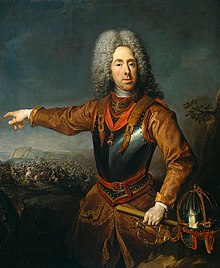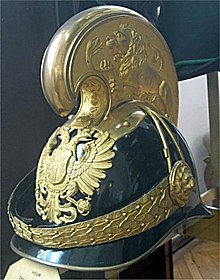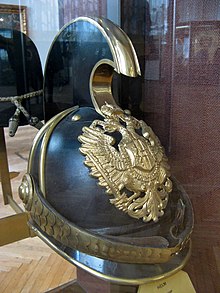
The Austro-Hungarian Army was the ground force of the Austro-Hungarian Dual Monarchy from 1867 to 1918. It was composed of three parts: the joint army, the Imperial Austrian Landwehr, and the Royal Hungarian Honvéd.

Jakob Ritter von Danner was a Bavarian general in the Imperial German Army and the Reichswehr. As commandant of the Munich garrison of the Reichswehr, he was a central figure in putting down the attempted Beer Hall Putsch by Adolf Hitler and the Nazis in 1923.
The 3rd Division was a unit of the Prussian/German Army. It was formed in Stettin in May 1816 as a Troop Brigade (Truppen-Brigade). It became the 3rd Division on September 5, 1818. From the corps' formation in 1820, the division was subordinated in peacetime to the II Army Corps. The 3rd Division was disbanded in 1919 during the demobilization of the German Army after World War I.
The 28th Division was a unit of the Prussian and German Army, almost entirely made up of troops from the Grand Duchy of Baden. It was formed in Karlsruhe on 1 July 1871. The division was subordinated in peacetime to the XIV Army Corps. The 28th Division was disbanded in 1919 during the demobilization of the German Army after World War I.
The 18th Division was a unit of the Prussian/German Army. It was formed on October 11, 1866, and was headquartered in Flensburg. The division was subordinated in peacetime to the IX Army Corps. The division was disbanded in 1919 during the demobilization of the German Army after World War I. The division was recruited primarily in Schleswig-Holstein.
The Kaiserjäger, were formed in 1895 as four normal infantry regiments within the Common Army of Austria-Hungary. Despite the name "Tirol" in its title its members were not just recruited from the crown land of Tyrol but also from other parts of the monarchy. The regiments were disbanded in 1918 with the end of the k.u.k. monarchy. The word Jäger is a characteristic term used for light infantry or light infantrymen in a German-speaking context.

The Bosnian-Herzegovinian Infantry, commonly called the Bosniaken, were a branch of the Austro-Hungarian Army. Recruited from outside the Austrian and Hungarian regions of the Dual-Monarchy, with a significant proportion of Muslim personnel (31.04%), these regiments enjoyed a special status. They had their own distinctive uniforms and were given their own numbering sequence within the Common Army (KuK).

Muhamed Hadžiefendić was a Bosnian Muslim officer in the Home Guard of the Independent State of Croatia during World War II, commanding the Hadžiefendić Legion.
The rank insignia of the Austro-Hungarian Navy were worn on and on sleeves for navy jackets and coats, or on shoulder straps of shirts and white jackets. Officers' ranks were indicated by lines of 1.3 centimetres (0.51 in) gold braid as were senior non-commissioned officers' ranks, enlisted men's rank was indicated by white stars on their square collar flaps. Senior officers and flag officers would wear a broader gold braid line of 3.3 centimetres (1.3 in) and 5.3 centimetres (2.1 in) resp. beneath smaller lines, in addition flag officers would wear a crown on top of their sleeve insignia.

The regiment was a cavalry unit raised in the 17th century for the Imperial Habsburg Army. Over the course of time, this unit became the 8th Bohemian Dragoons within the "Common Army" that formed part of the Austro-Hungarian Army. From 1888 the unit was to bear this new title "in perpetuity".

Together with the Dragoons and Uhlans, the Imperial and Royal Hussars, made up the cavalry of the Austro-Hungarian Army from 1867 to 1918, both in the Common Army and in the Hungarian Landwehr, where they were known as the Royal Hungarian Hussars.

The Common Army as it was officially designated by the Imperial and Royal Military Administration, was the largest part of the Austro-Hungarian land forces from 1867 to 1914, the other two elements being the Imperial-Royal Landwehr and the Royal Hungarian Landwehr. However, it was simply known as the Army (Heer) by the Emperor and in peacetime laws, and, after 1918, colloquially called the k.u.k. Armee.

Together with the Dragoons and Hussars, the Imperial and Royal Uhlans, made up the cavalry of the Austro-Hungarian Army from 1867 to 1918, both in the Common Army and in the Austrian Landwehr, where they were known as the Imperial-Royal Landwehr Uhlans.

The Imperial-Royal Landwehr, also called the Austrian Landwehr, was the territorial army of the Cisleithanian or Austrian half of the Austro-Hungarian Empire from 1869 to 1918. Its counterpart was the Royal Hungarian Landwehr. The two Landwehrs, together with the Common Army and the Imperial and Royal Navy, made up the armed forces of Austria-Hungary. While the name, "Imperial-Royal", might seem to suggest a link between the "Imperial" (Cisleithanian) and "Royal" halves of the Empire, in this context "Royal" actually refers to the Kingdom of Bohemia - not a sovereign kingdom on par with the Kingdom of Hungary, but a crownland of Cisleithanian Austria-Hungary and possession of the Habsburgs, who remained formally entitled to kingship. In this sense, the Kingdom of Bohemia was comparable in status to the Kingdom of Galicia and Lodomeria and the Kingdom of Dalmatia.

The Royal Hungarian Honvéd or Royal Hungarian Landwehr, commonly known as the Honvéd, was one of the four armed forces of Austria-Hungary from 1867 to 1918, along with the Austrian Landwehr, the Common Army and the Imperial and Royal Navy. The term honvéd was used to refer to all members of the Hungarian land forces in 1848-49, but it was also used to refer to enlisted private soldiers without a rank.

The Imperial-Royal Mountain Troops were founded in 1906 as part of the Austrian Landwehr, the territorial army of the Cisleithanian half of the Austro-Hungarian Empire. As a result, the abbreviation "k.k." was used and not "k.u.k." which would have implied a connexion with the Hungarian half of the Empire.
The Imperial and Royal Infantry was an arm of the Common Army of the Austro-Hungarian monarchy and comprised two elements:

Adjustierung is derived from the German (Austrian) verb adjustieren is in Austrian armed forces the generic term to a defined type uniform, as well as the paraphrase to a specific dress and equipment to be worn by military personnel. However, another historical designation to military uniform, e.g. in the Austro-Hungarian Army (1867–1918), was Montur, and in the Prussian Army Montierung.

The Paroli was initially the designation for the coloured gorget patches of the Austro-Hungarian Army. It is applied on the gorget of a uniform coat or jacket and the battle-dress blouse. The Parolis indicated the egalisation colour and served as discrimination criteria of the 102 infantry regiments of the Austro-Hungarian Army, as well as dragoon regiment and the regiment of the uhlans. In other German-speaking armed forces, the designation was called Kragenpatte, Kragenspiegel, or Arabesque.
The Feldjäger were established in 1808 as Jäger infantry in the Empire of Austria and later formed part of the regular infantry of the Common Army, only their peacetime uniform distinguishing them. The designation Jäger for the soldiers and Feldjäger for their units had purely historical reasons, as light infantry and skirmisher units had been abolished in 1866.




















